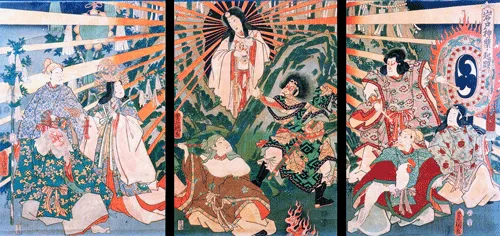Amaterasu Omikami is the incarnate goddess of the Sun. She governs the Universe and is the main deity of the Japanese Shinto religion. It is believed that the royal family of Japan descends directly from this important goddess. She represents fertility and makes plants grow that give life not only to humans but also to the gods. As the guardian of the Japanese people, she is represented by the emblem of the rising sun on the Japanese flag. The meaning of her full name, Amaterasu-ōmikami means ‘the great kami (goddess) that shines in the sky’.

The stories and myths about Amaterasu come from the Kojiki. This is the oldest book in Japan that was completed in 712 and means ‘Record of Ancient Things’. Before the written form came into existence, the Kojiki was transmitted orally. It contains myths, legends, songs, genealogies, and statements. It also contains historical narratives about the Imperial Court of Japan, families, and their origins.
According to Kojiki, Amaterasu was born when Izanagi, a primordial male deity washed his left eye during a purification process. Izanagi entrusted her with his necklace and was given power over the heavens. His brother, the storm god Susanowo, was born when Izanagi washed his nose and was given the power of the oceans.
Symbols of Amaterasu Omikami
You will find several symbols in depictions of Amaterasu, here are some of them explained:
Mirror: The original mirror that reflected Amaterasu was made by the blacksmith of the gods. It is kept in the Great Shrine in Ise in central Japan and it’s called Yata no Kagami. To this day, the sanctuary accepts visitors, and you can see the building where the mirror is stored. The mirror itself, however, has been hidden for 1,500 years. It is said that the mirror has eight sides since eight represents the number of perfection in Shinto. All mirrors are considered sacred to Amaterasu and it is a way to connect with her and reflect the state of the viewer’s soul. A Japanese proverb says: “When the mirror is dark, the soul is not pure.”
Necklace: As mentioned earlier, at the time of her birth, Amaterasu received a sacred necklace from Izanagi. It is also said that a jewel of this necklace is consecrated in the Great Sanctuary of Ise.
Solar Sword: Amaterasu is the guardian of the Japanese people and in her role as protector, the solar sword represents her martial attributes. It is also an indication of her ability to take her people to war when necessary.
The mirror, the necklace, and the sword are considered the three emblems of the Imperial Japanese Royalty and the three symbols of Shinto.
Shintoism in Japan
Shinto is the pre-Buddhist indigenous religion of Japan and is the most important religion today. It is worth noting that Japanese Shinto that focuses on honoring nature and the concerns of everyday life is frequently practiced together with Buddhism, which focuses on the concerns of future life. It is considered that many Buddhist deities are also Shinto Kami (gods).
Your Japan Tour
As seasoned Japan experts, we create perfect Japan package tours including guides who can answer all your questions about the Shinto religion and Amaterasu Omikami. Check out our group tours and private tours, or contact us to start planning your unforgettable holiday to this fascinating country full of once-in-a-lifetime experiences, culture, history, nature, and delicious food!